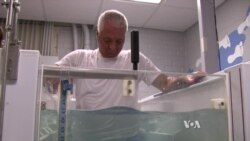Tim Patterson is taking a short walk across the campus of Middle Tennessee State University. It's a remarkable feat for a man who's been paralyzed for seven years.
A tumor on his spine left Patterson confined to a wheelchair, but his involvment in groundbreaking new research has given him new hope.
For the past two years, Patterson has participated in mobility research at MTSU’s Human Performance Lab. The lab is exploring the use of water treadmills as a way to improve the mobility of individuals with disabilities.
The treadmills look like large aquariums. Patterson stands chest deep in water with his arms braced on the sides of the tank. Through the treadmill’s glass front, you can see his feet stepping slowly along a belt crawling across the tank’s floor. Sweat beads on his forehead as he struggles to keep his feet moving forward.
“I had no movement in my feet whatsoever before we started the program," Patterson said, "and now I’m up on the walker, walking maybe 90 feet [27 meters] before I have to sit down. So it’s drastic.”
Lead researcher Dr. Sandy Stevens hovers at the side of the tank as Patterson walks. She times each short session with a stop watch and makes small changes in the treadmill's speed. Stevens says therapy in water is ideal because there’s less chance of injury from a fall, and water makes the legs lighter and easier to move.
“With very minimal control, very limited muscle strength, they can take a step forward," he said. "And once you build that pattern, then you have something to work with.”
Walking is partially a reflex action. Even when a spinal cord injury severs the connection to the brain, the legs "remember" how to take a step.
“The stimulus for walking is weight bearing in an upright position," Stevens said. "If we can provide an environment that allows that, then a natural step will occur even if the brain can’t stimulate it.”
The MTSU research suggests water therapy can provide small, but significant, improvements in walking ability. Stevens notes, even those modest changes can have a dramatic impact on the lives of people with impairments.
“You can visit someone in their home, you can feel comfortable going into a community setting not worrying about whether or not you’re going to be able to get into a bathroom," Stevens said. "A lot of options open up for you in the community.”
Human Performance Lab director Don Morgan is planning the next phase of the research, which will explore why the water treadmill helps improve mobility.
“For example, are certain areas of the brain turning on where they didn’t turn on before? Are there certain sections of the spinal cord that have been re-enervated as a result of what’s going on in the periphery? In other words, what’s going on at the legs,” Morgan said.
Regardless of where this line of research might lead, it has at least given people with disabilities hope for the future.
“They can do more things, at home, in their community, at their school," Morgan said. "To begin to lead a new normal life, but still a normal life, I mean is still incredibly amazing.”
The university recently received a nearly $500,000 research grant to continue the treadmill studies. The Human Performance Lab is now looking for research partners and additional research subjects.





